[English] 日本語
 Yorodumi
Yorodumi- PDB-6snw: Structure of Coxsackievirus A10 complexed with its receptor KREMEN1 -
+ Open data
Open data
- Basic information
Basic information
| Entry | Database: PDB / ID: 6snw | ||||||||||||
|---|---|---|---|---|---|---|---|---|---|---|---|---|---|
| Title | Structure of Coxsackievirus A10 complexed with its receptor KREMEN1 | ||||||||||||
 Components Components |
| ||||||||||||
 Keywords Keywords | VIRUS / CV-A10 / KREMEN1 / Virus-receptor complex / Hand / foot and mouth disease / picornavirus uncoating intermediate | ||||||||||||
| Function / homology |  Function and homology information Function and homology informationSignaling by LRP5 mutants / Negative regulation of TCF-dependent signaling by WNT ligand antagonists / negative regulation of axon regeneration / cell communication / negative regulation of ossification / regulation of canonical Wnt signaling pathway / limb development / symbiont-mediated suppression of host cytoplasmic pattern recognition receptor signaling pathway via inhibition of MDA-5 activity / TCF dependent signaling in response to WNT / picornain 2A ...Signaling by LRP5 mutants / Negative regulation of TCF-dependent signaling by WNT ligand antagonists / negative regulation of axon regeneration / cell communication / negative regulation of ossification / regulation of canonical Wnt signaling pathway / limb development / symbiont-mediated suppression of host cytoplasmic pattern recognition receptor signaling pathway via inhibition of MDA-5 activity / TCF dependent signaling in response to WNT / picornain 2A / symbiont-mediated suppression of host mRNA export from nucleus / symbiont genome entry into host cell via pore formation in plasma membrane / picornain 3C / T=pseudo3 icosahedral viral capsid / negative regulation of canonical Wnt signaling pathway / host cell cytoplasmic vesicle membrane / Wnt signaling pathway / transmembrane signaling receptor activity / nucleoside-triphosphate phosphatase / channel activity / monoatomic ion transmembrane transport / DNA replication / RNA helicase activity / endocytosis involved in viral entry into host cell / symbiont-mediated activation of host autophagy / RNA-directed RNA polymerase / cysteine-type endopeptidase activity / viral RNA genome replication / neuronal cell body / RNA-directed RNA polymerase activity / apoptotic process / DNA-templated transcription / virion attachment to host cell / host cell nucleus / structural molecule activity / signal transduction / ATP hydrolysis activity / proteolysis / RNA binding / zinc ion binding / ATP binding / membrane / plasma membrane Similarity search - Function | ||||||||||||
| Biological species |  Homo sapiens (human) Homo sapiens (human)  Coxsackievirus A10 Coxsackievirus A10 | ||||||||||||
| Method | ELECTRON MICROSCOPY / single particle reconstruction / cryo EM / Resolution: 3.9 Å | ||||||||||||
 Authors Authors | Zhao, Y. / Zhou, D. / Ni, T. / Karia, D. / Kotecha, A. / Wang, X. / Rao, Z. / Jones, E.Y. / Fry, E.E. / Ren, J. / Stuart, D.I. | ||||||||||||
| Funding support |  United Kingdom, 3items United Kingdom, 3items
| ||||||||||||
 Citation Citation |  Journal: Nat Commun / Year: 2020 Journal: Nat Commun / Year: 2020Title: Hand-foot-and-mouth disease virus receptor KREMEN1 binds the canyon of Coxsackie Virus A10. Authors: Yuguang Zhao / Daming Zhou / Tao Ni / Dimple Karia / Abhay Kotecha / Xiangxi Wang / Zihe Rao / E Yvonne Jones / Elizabeth E Fry / Jingshan Ren / David I Stuart /    Abstract: Coxsackievirus A10 (CV-A10) is responsible for an escalating number of severe infections in children, but no prophylactics or therapeutics are currently available. KREMEN1 (KRM1) is the entry ...Coxsackievirus A10 (CV-A10) is responsible for an escalating number of severe infections in children, but no prophylactics or therapeutics are currently available. KREMEN1 (KRM1) is the entry receptor for the largest receptor-group of hand-foot-and-mouth disease causing viruses, which includes CV-A10. We report here structures of CV-A10 mature virus alone and in complex with KRM1 as well as of the CV-A10 A-particle. The receptor spans the viral canyon with a large footprint on the virus surface. The footprint has some overlap with that seen for the neonatal Fc receptor complexed with enterovirus E6 but is larger and distinct from that of another enterovirus receptor SCARB2. Reduced occupancy of a particle-stabilising pocket factor in the complexed virus and the presence of both unbound and expanded virus particles suggests receptor binding initiates a cascade of conformational changes that produces expanded particles primed for viral uncoating. | ||||||||||||
| History |
|
- Structure visualization
Structure visualization
| Movie |
 Movie viewer Movie viewer |
|---|---|
| Structure viewer | Molecule:  Molmil Molmil Jmol/JSmol Jmol/JSmol |
- Downloads & links
Downloads & links
- Download
Download
| PDBx/mmCIF format |  6snw.cif.gz 6snw.cif.gz | 211.2 KB | Display |  PDBx/mmCIF format PDBx/mmCIF format |
|---|---|---|---|---|
| PDB format |  pdb6snw.ent.gz pdb6snw.ent.gz | 163.1 KB | Display |  PDB format PDB format |
| PDBx/mmJSON format |  6snw.json.gz 6snw.json.gz | Tree view |  PDBx/mmJSON format PDBx/mmJSON format | |
| Others |  Other downloads Other downloads |
-Validation report
| Summary document |  6snw_validation.pdf.gz 6snw_validation.pdf.gz | 1 MB | Display |  wwPDB validaton report wwPDB validaton report |
|---|---|---|---|---|
| Full document |  6snw_full_validation.pdf.gz 6snw_full_validation.pdf.gz | 1 MB | Display | |
| Data in XML |  6snw_validation.xml.gz 6snw_validation.xml.gz | 35 KB | Display | |
| Data in CIF |  6snw_validation.cif.gz 6snw_validation.cif.gz | 53.7 KB | Display | |
| Arichive directory |  https://data.pdbj.org/pub/pdb/validation_reports/sn/6snw https://data.pdbj.org/pub/pdb/validation_reports/sn/6snw ftp://data.pdbj.org/pub/pdb/validation_reports/sn/6snw ftp://data.pdbj.org/pub/pdb/validation_reports/sn/6snw | HTTPS FTP |
-Related structure data
| Related structure data |  10263MC  6smgC  6snbC C: citing same article ( M: map data used to model this data |
|---|---|
| Similar structure data |
- Links
Links
- Assembly
Assembly
| Deposited unit | 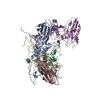
|
|---|---|
| 1 | x 60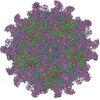
|
- Components
Components
-Capsid protein ... , 2 types, 2 molecules AC
| #1: Protein | Mass: 33191.422 Da / Num. of mol.: 1 / Source method: isolated from a natural source / Source: (natural)   Coxsackievirus A10 Coxsackievirus A10References: UniProt: Q6JKR9, picornain 2A, nucleoside-triphosphate phosphatase, picornain 3C, RNA-directed RNA polymerase |
|---|---|
| #3: Protein | Mass: 26219.672 Da / Num. of mol.: 1 / Source method: isolated from a natural source / Source: (natural)   Coxsackievirus A10 Coxsackievirus A10References: UniProt: Q6JKR9, picornain 2A, nucleoside-triphosphate phosphatase, picornain 3C, RNA-directed RNA polymerase |
-Coxsackievirus ... , 2 types, 2 molecules BD
| #2: Protein | Mass: 27729.980 Da / Num. of mol.: 1 / Source method: isolated from a natural source / Source: (natural)   Coxsackievirus A10 Coxsackievirus A10References: UniProt: Q6JKR9, picornain 2A, nucleoside-triphosphate phosphatase, picornain 3C, RNA-directed RNA polymerase |
|---|---|
| #4: Protein | Mass: 7464.065 Da / Num. of mol.: 1 / Source method: isolated from a natural source / Source: (natural)   Coxsackievirus A10 Coxsackievirus A10References: UniProt: Q6JKR9, picornain 2A, nucleoside-triphosphate phosphatase, picornain 3C, RNA-directed RNA polymerase |
-Protein / Non-polymers / Sugars , 3 types, 4 molecules E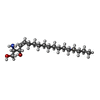



| #5: Protein | Mass: 41786.293 Da / Num. of mol.: 1 Source method: isolated from a genetically manipulated source Source: (gene. exp.)  Homo sapiens (human) / Gene: KREMEN1, KREMEN, KRM1 / Cell (production host): HEK293S / Production host: Homo sapiens (human) / Gene: KREMEN1, KREMEN, KRM1 / Cell (production host): HEK293S / Production host:  Homo sapiens (human) / References: UniProt: Q96MU8 Homo sapiens (human) / References: UniProt: Q96MU8 |
|---|---|
| #6: Chemical | ChemComp-SPH / |
| #7: Sugar |
-Details
| Has ligand of interest | N |
|---|---|
| Has protein modification | Y |
-Experimental details
-Experiment
| Experiment | Method: ELECTRON MICROSCOPY |
|---|---|
| EM experiment | Aggregation state: PARTICLE / 3D reconstruction method: single particle reconstruction |
- Sample preparation
Sample preparation
| Component |
| ||||||||||||||||||||||||
|---|---|---|---|---|---|---|---|---|---|---|---|---|---|---|---|---|---|---|---|---|---|---|---|---|---|
| Source (natural) |
| ||||||||||||||||||||||||
| Source (recombinant) | Organism:  Homo sapiens (human) / Cell: HEK293S Homo sapiens (human) / Cell: HEK293S | ||||||||||||||||||||||||
| Details of virus | Empty: NO / Enveloped: NO / Isolate: STRAIN / Type: VIRION | ||||||||||||||||||||||||
| Natural host | Organism: Homo sapiens | ||||||||||||||||||||||||
| Buffer solution | pH: 8 | ||||||||||||||||||||||||
| Specimen | Embedding applied: NO / Shadowing applied: NO / Staining applied: NO / Vitrification applied: YES | ||||||||||||||||||||||||
| Vitrification | Cryogen name: ETHANE |
- Electron microscopy imaging
Electron microscopy imaging
| Experimental equipment |  Model: Tecnai Polara / Image courtesy: FEI Company |
|---|---|
| Microscopy | Model: FEI POLARA 300 |
| Electron gun | Electron source:  FIELD EMISSION GUN / Accelerating voltage: 300 kV / Illumination mode: FLOOD BEAM FIELD EMISSION GUN / Accelerating voltage: 300 kV / Illumination mode: FLOOD BEAM |
| Electron lens | Mode: BRIGHT FIELD |
| Image recording | Electron dose: 35 e/Å2 / Film or detector model: GATAN K2 SUMMIT (4k x 4k) / Num. of grids imaged: 1 |
- Processing
Processing
| Software | Name: PHENIX / Version: dev_3488: / Classification: refinement | ||||||||||||||||||||||||
|---|---|---|---|---|---|---|---|---|---|---|---|---|---|---|---|---|---|---|---|---|---|---|---|---|---|
| EM software | Name: PHENIX / Category: model refinement | ||||||||||||||||||||||||
| CTF correction | Type: PHASE FLIPPING AND AMPLITUDE CORRECTION | ||||||||||||||||||||||||
| 3D reconstruction | Resolution: 3.9 Å / Resolution method: FSC 0.143 CUT-OFF / Num. of particles: 1597 / Symmetry type: POINT | ||||||||||||||||||||||||
| Atomic model building | Protocol: RIGID BODY FIT / Space: REAL | ||||||||||||||||||||||||
| Refine LS restraints |
|
 Movie
Movie Controller
Controller




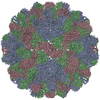
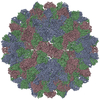


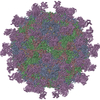
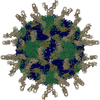
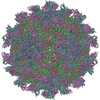
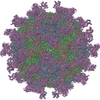

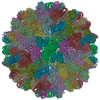
 PDBj
PDBj







